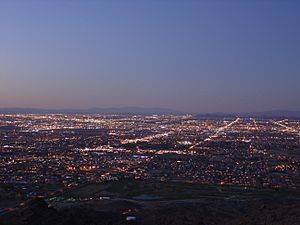South Phoenix facts for kids
South Phoenix is a part of Phoenix, Arizona. It is generally located south of the Salt River. It stretches north of Roeser Road, east of 24th Street, and west of 32nd Street.
Contents
History of South Phoenix
The first land was bought in South Phoenix around what is now 15th Avenue and Broadway Road. This happened in 1871 when Noah Matthew Broadway bought land for his Broadway Ranch. Before this, only a few Mexican farmers lived south of the Salt River.
In 1873, a merchant named Michael Wormser helped these farmers. He later took over their land when they couldn't pay their debts. He ended up owning about 9,000 acres (36 km2) of land in South Phoenix and Tempe. After Wormser passed away, much of his land was bought by Dwight B. Heard in 1901. Heard also ran The Arizona Republican newspaper. This land became the Bartlett-Heard Ranch. It started being sold for homes in 1910. Many small farms were created in an area later called Roosevelt Place.
Railroad tracks were built south of the Salt River. Also, big floods, like one in 1891, caused many White residents to move north. This left minority residents living in South Phoenix.
Farming and Ostrich Farms
Between 1912 and 1913, the Highline and Western canals were built. These canals brought water from the Salt River to the South Mountain area. This helped farming grow even more. People raised cattle and grew crops like alfalfa, cotton, and citrus fruits. They also grew canaigre, a plant used to make leather.
Did you know there were ostrich farms here? Louis Janssens had a Belgian-American Ostrich Farm on 230 acres (0.93 km2) of land. It operated until World War I. Two other families also had ostrich farms in South Phoenix. These farms were located between 16th Street and 40th Street, south of Southern Avenue.
Japanese American Farmers
In 1928, Kajuio Kishiyama started farming vegetables near South Mountain. He leased his land because a law called the Arizona Alien Land Law of 1921 stopped "Orientals" from owning land. This law was later found to be unconstitutional. Kishiyama successfully grew flowers near the Western Canal. Another Japanese family, the Nakagawas, also arrived in the 1930s.
During World War II, these families were forced to move to internment camps. There were two such camps in Arizona. After the war, the Kishiyama and Nakagawa families bravely returned. They started over and successfully grew large fields of flowers, lettuce, and other vegetables.
Historic Places to Visit
South Phoenix has many interesting historic and natural places. These include Mystery Castle, a unique home built from recycled materials. There is also Heard Scout Pueblo, a place for Scouts. The San Francisco Xavier Mission, built in 1940, is open to the public on weekends. You can also visit The Farm at South Mountain, a beautiful farm area. South Mountain Park is a huge city park with great views. And don't forget Scorpion Gulch, which has historic buildings at the park's entrance.
Geography of South Phoenix
People have different ideas about where South Phoenix truly begins and ends.
The Phoenix Police Department includes South Phoenix in a police area that also covers Ahwatukee. Ahwatukee is usually seen as part of the East Valley area of Phoenix.
Another group, First Things First, defines South Phoenix differently. They say it is west of 48th Street, east of 27th Avenue, south of the Salt River, and north of South Mountain. This definition does not include Ahwatukee.
People and Growth
Historically, rules about where different groups of people could live shaped South Phoenix. A railroad line in Phoenix often marked the boundary between the White part of the city and South Phoenix. By the 1890s, rules about where people could live and how land was used in minority areas began to affect the environment and living conditions.
For many years, until the 1970s, South Phoenix was the only part of the city where African American and Mexican American families could buy homes. This was because of rules that limited housing in other parts of the city.
Since the late 1990s, especially after 2002, South Phoenix has grown a lot. Many citrus groves and flower fields have become new housing areas and shops. Because it is close to downtown Phoenix, the housing market in South Phoenix is still doing well.
Today, much of the area is mostly Latino. However, areas closer to downtown and Tempe still have a large African-American population. For example, one area between Broadway and Baseline has a population that is 56.3% African-American. This is the highest percentage in all of Arizona. Other neighborhoods with a strong African-American history include Hermoso, South Vistas, Lindo Park, and Park South.
Businesses in South Phoenix
The main offices for the Apollo Group are in the South Mountain Village area. This company owns University of Phoenix and Western International University. The corporate offices for SuperShuttle Int. and Ace Asphalt are also located here.
Media Coverage
The South Mountain Village area has its own community newspaper called South Mountain District News. It also covers news from Laveen, which is west of South Mountain Village. This newspaper is free and comes out once a month.
Another local newspaper, South Mountain Villager, also covers the area. It has a special rule: it only prints positive stories about the community.


